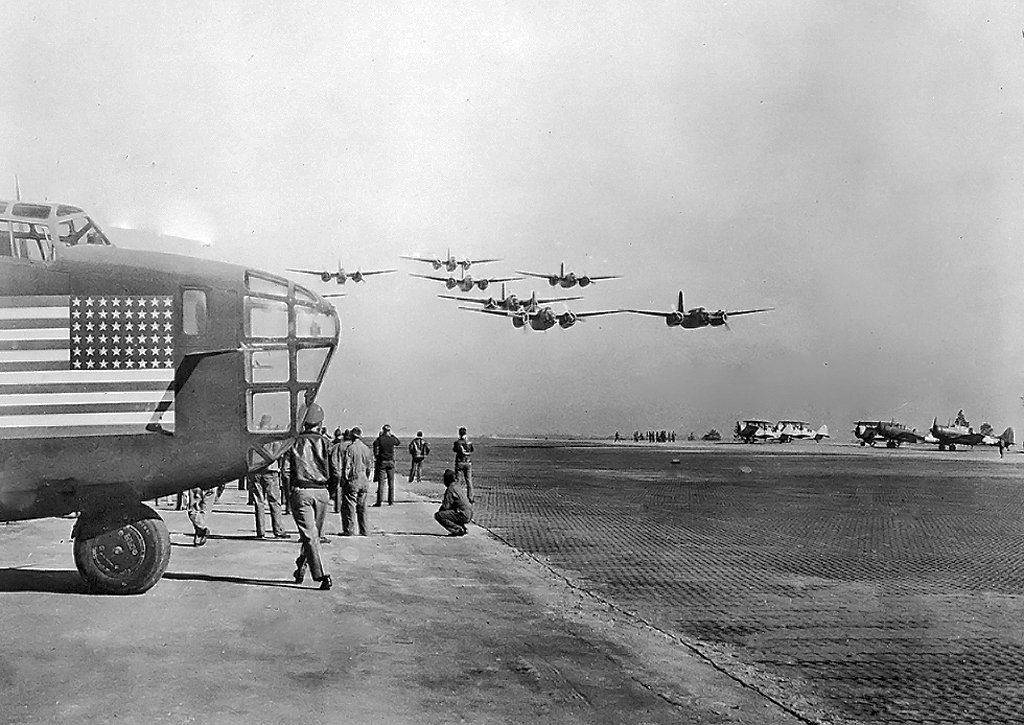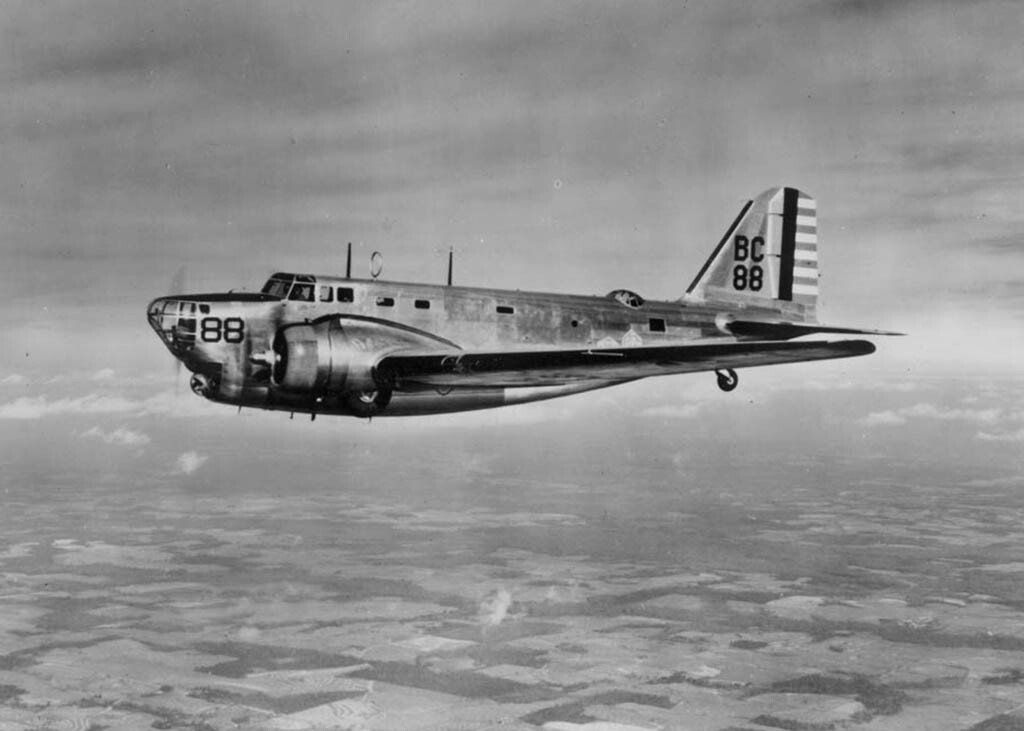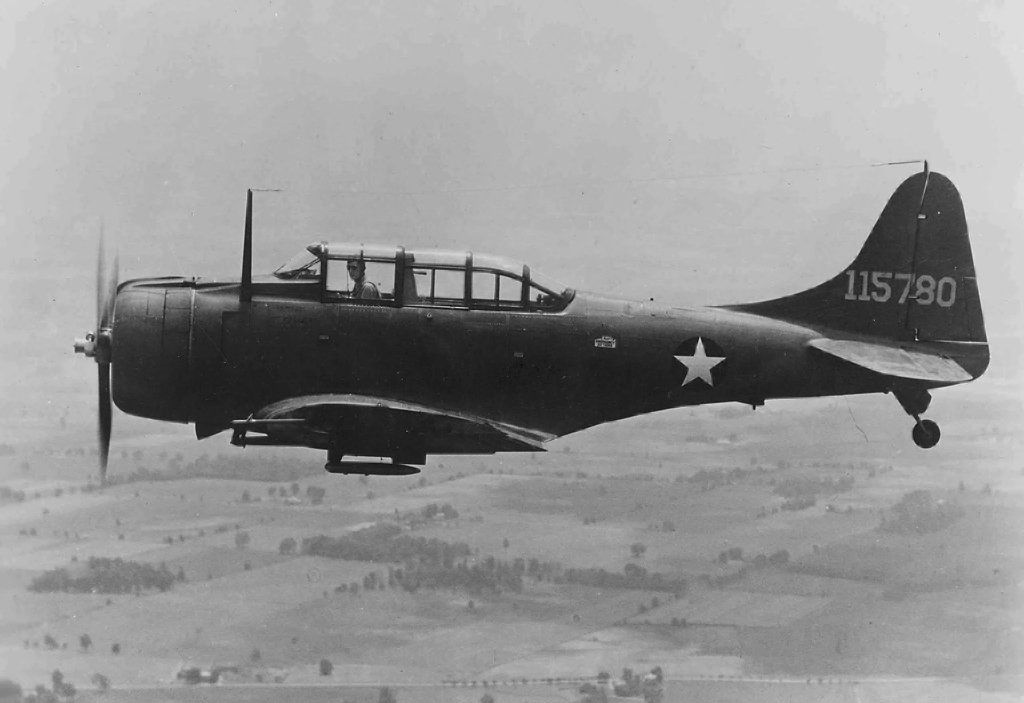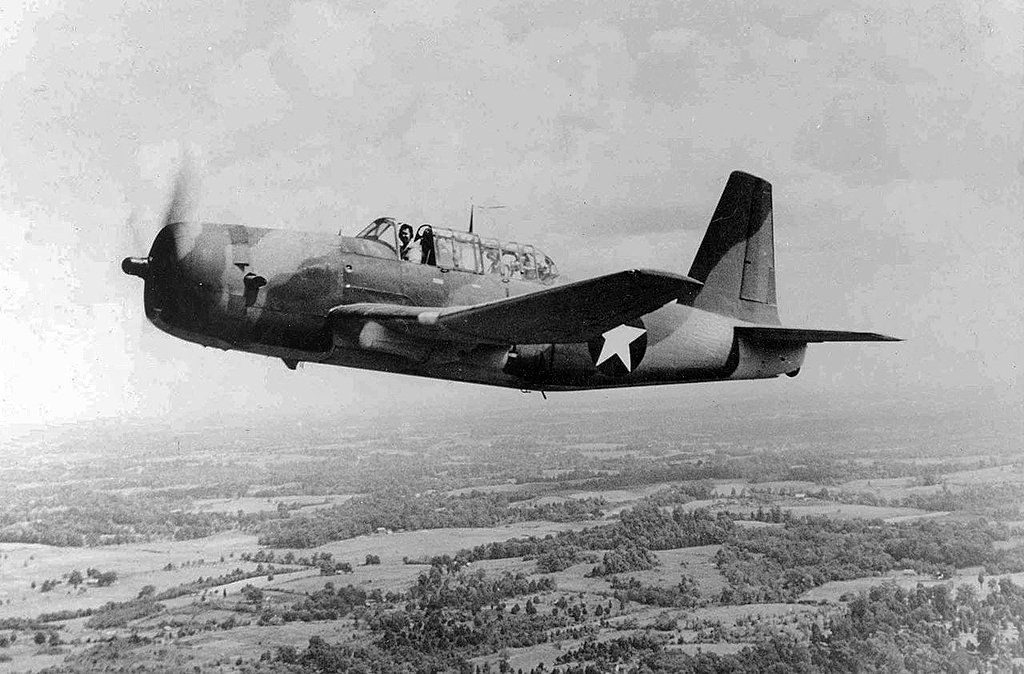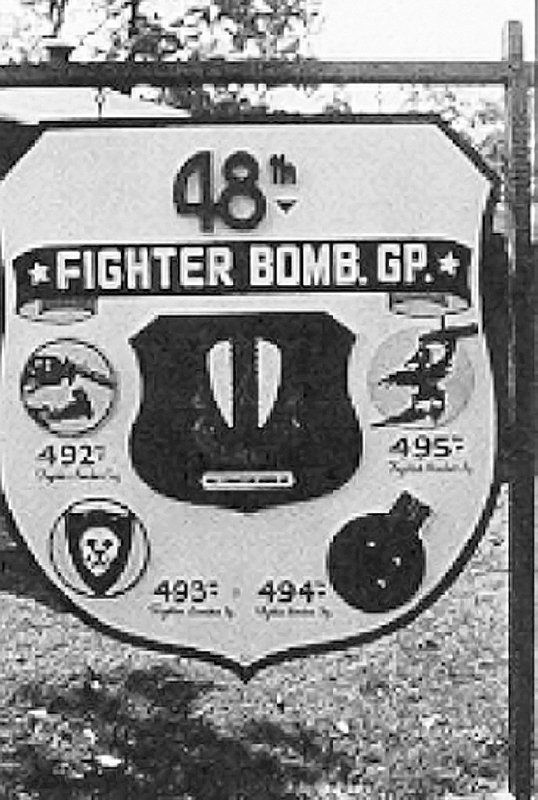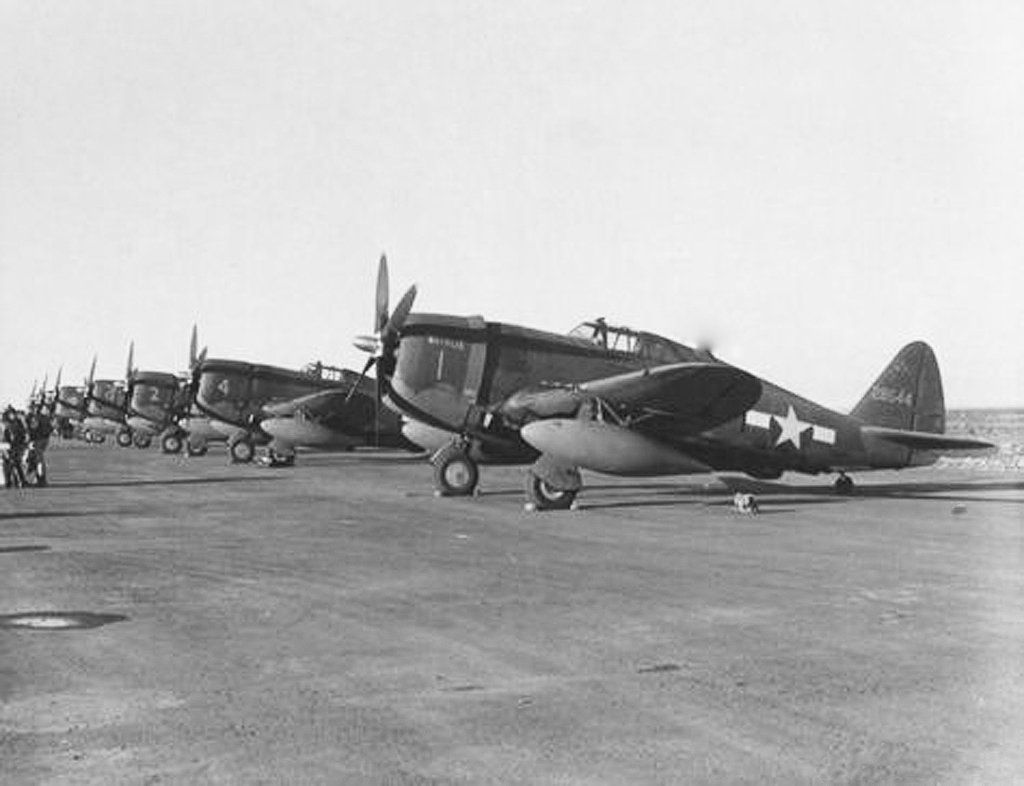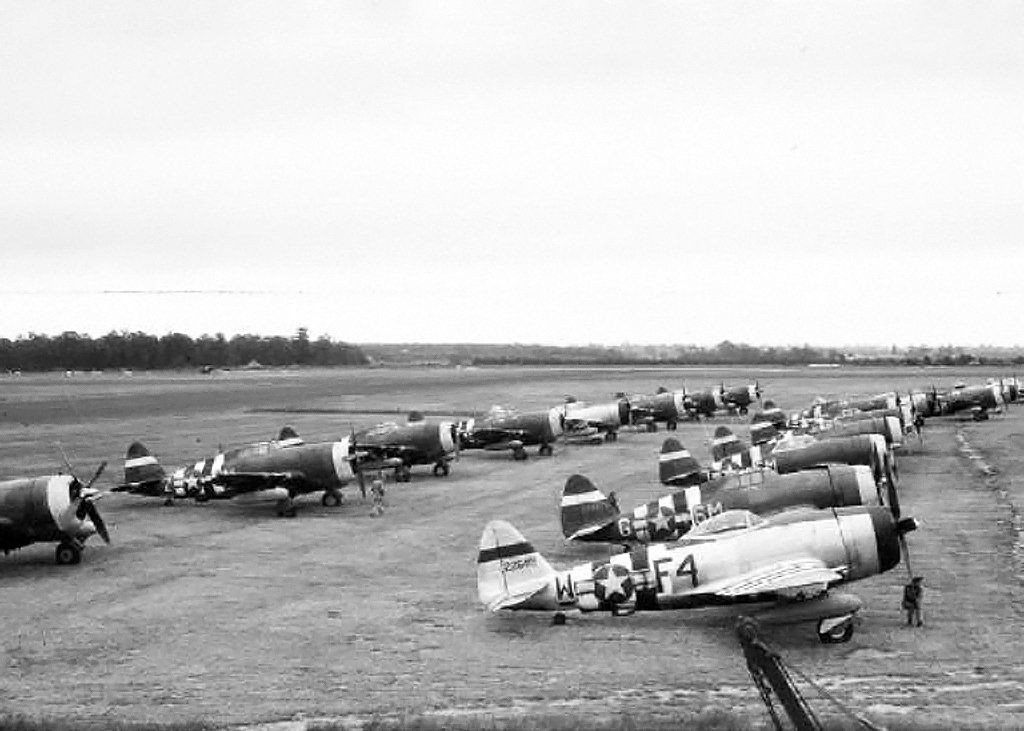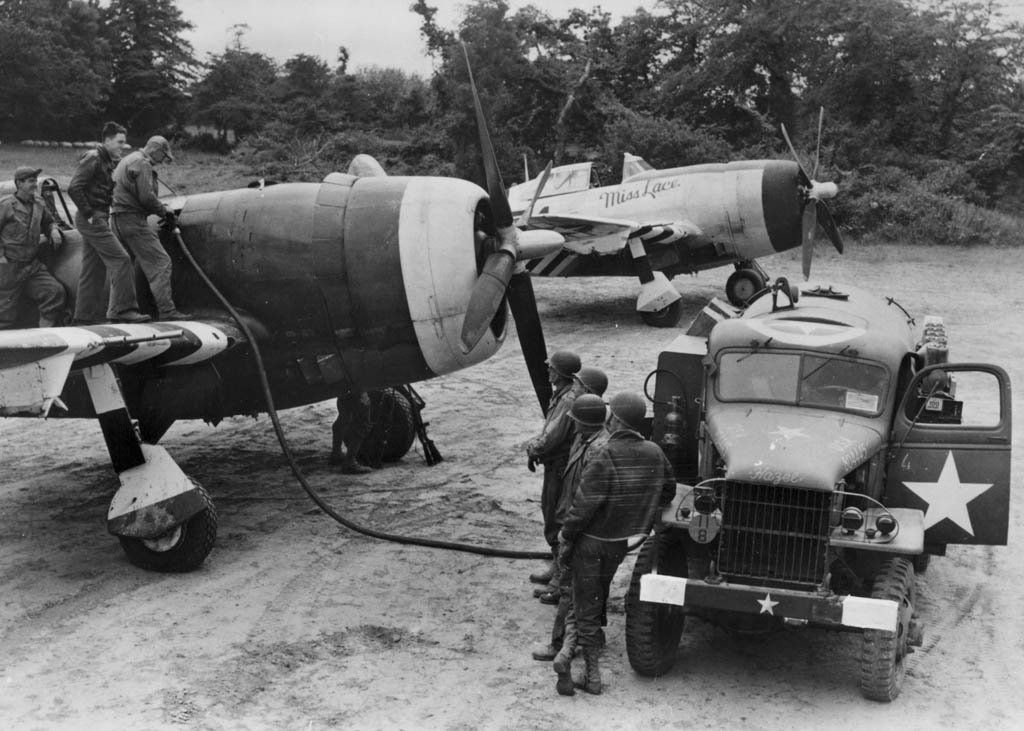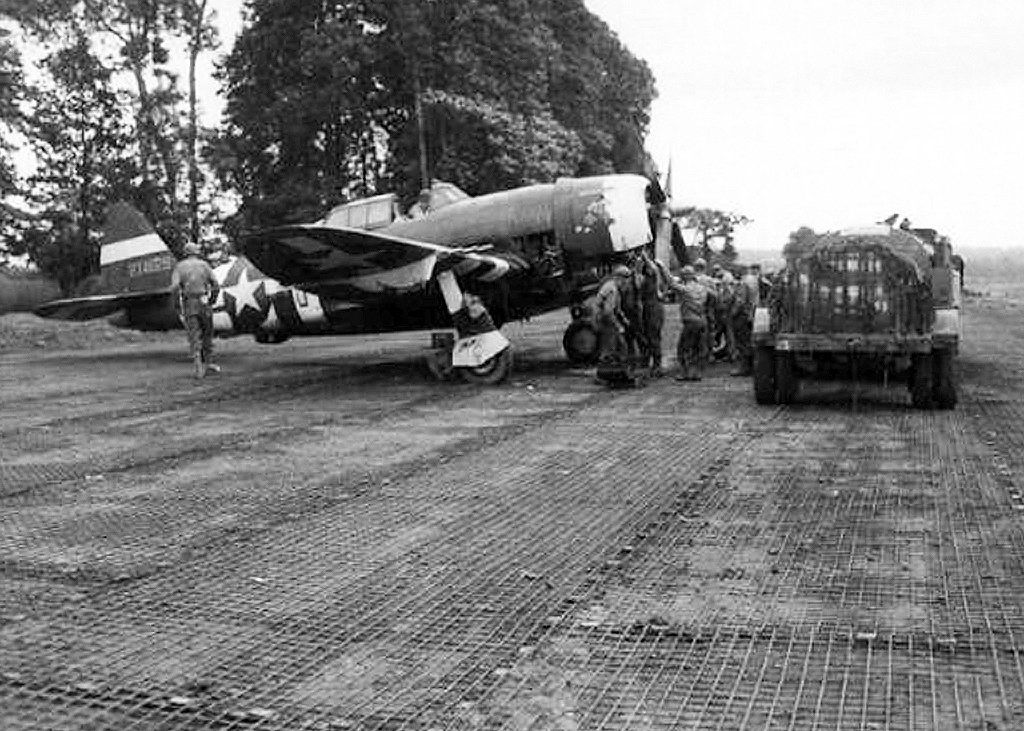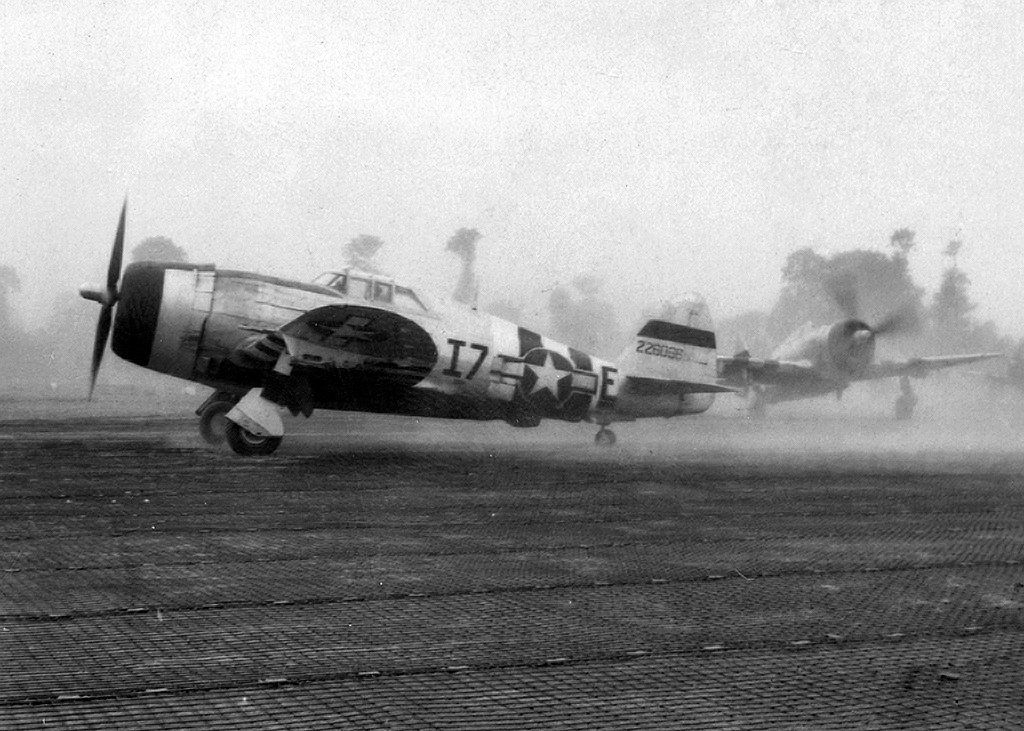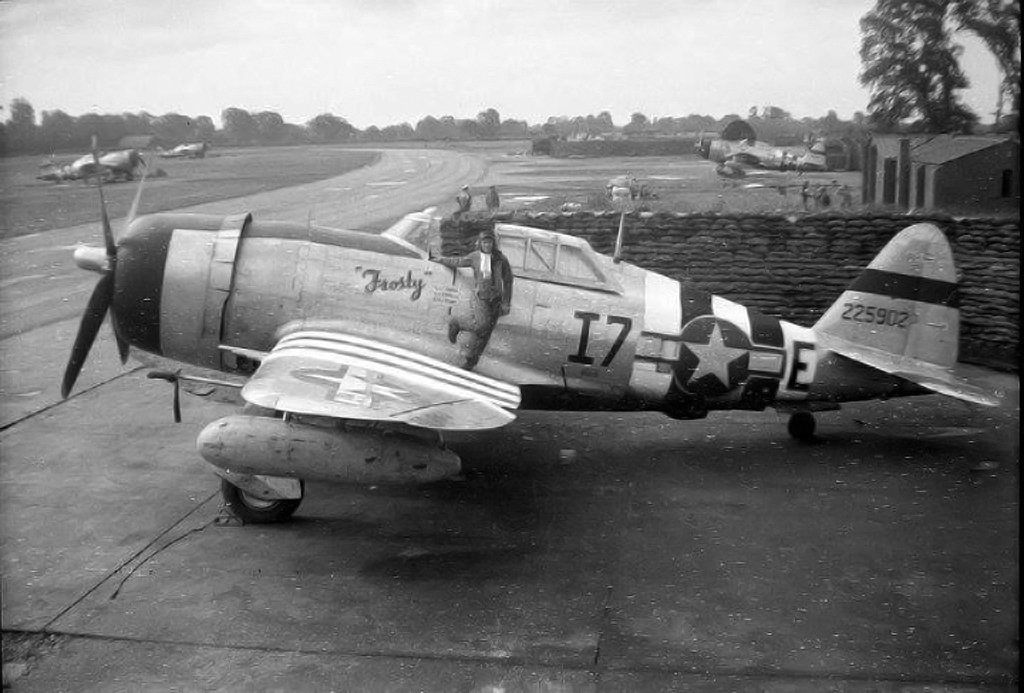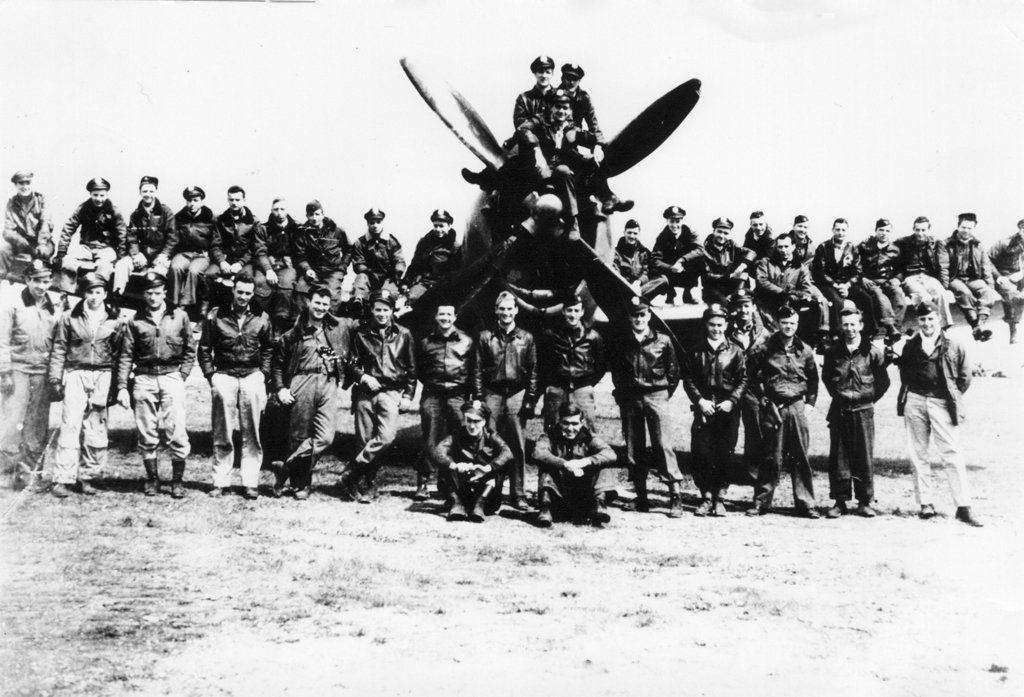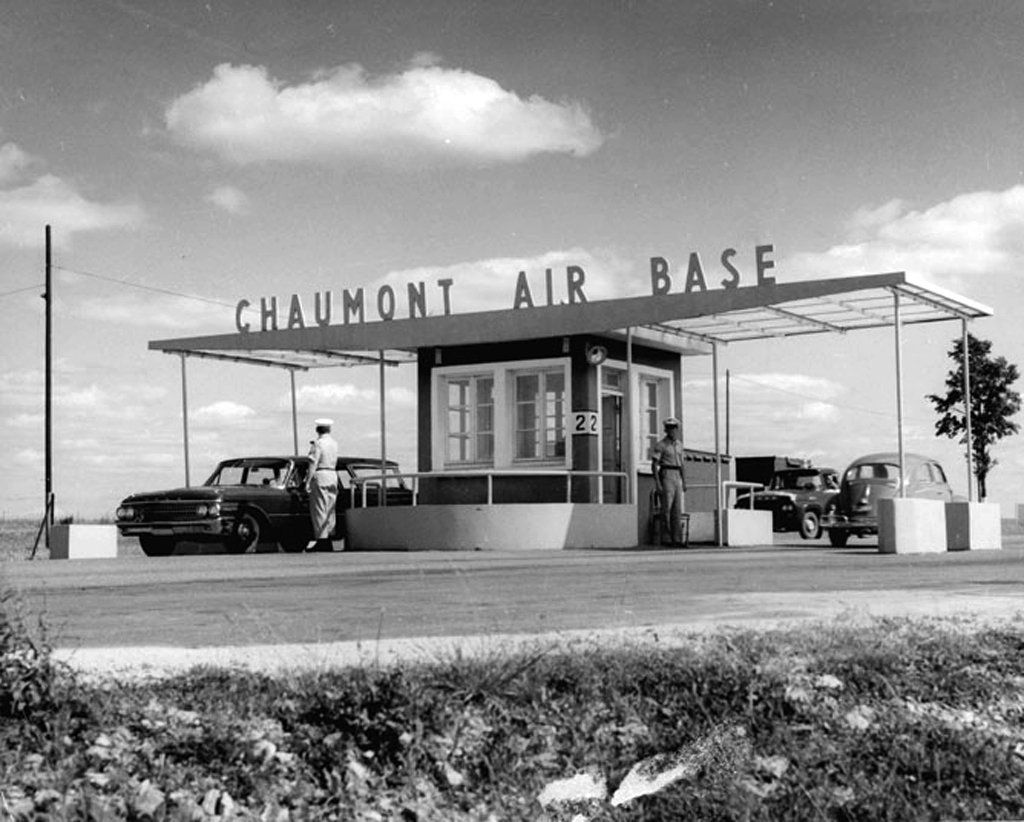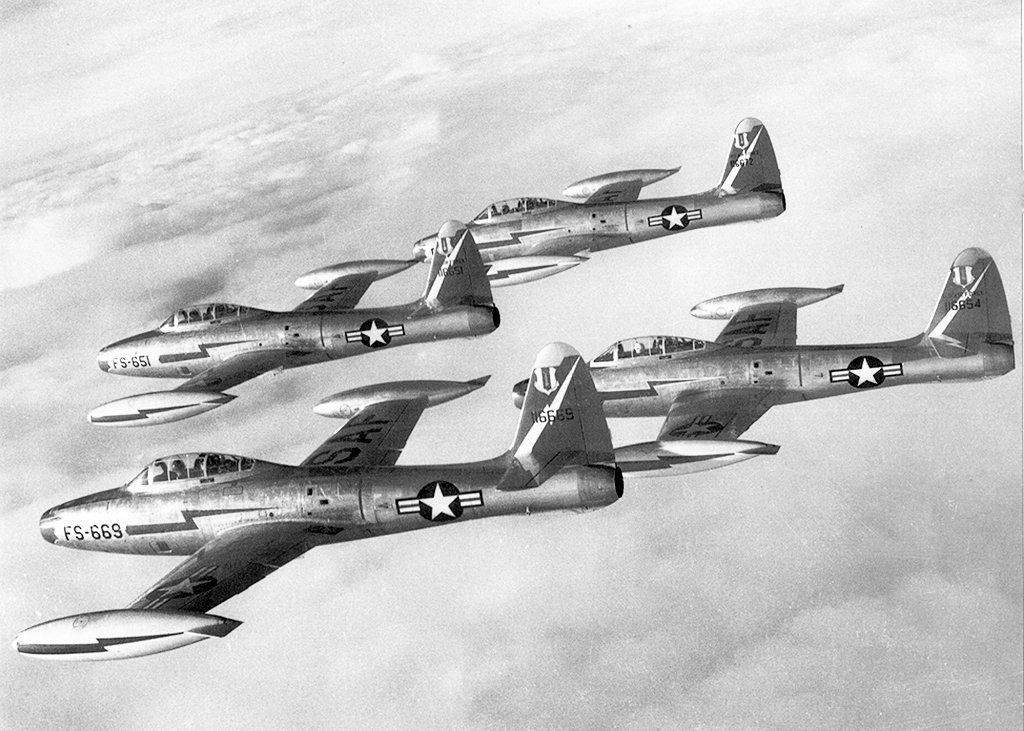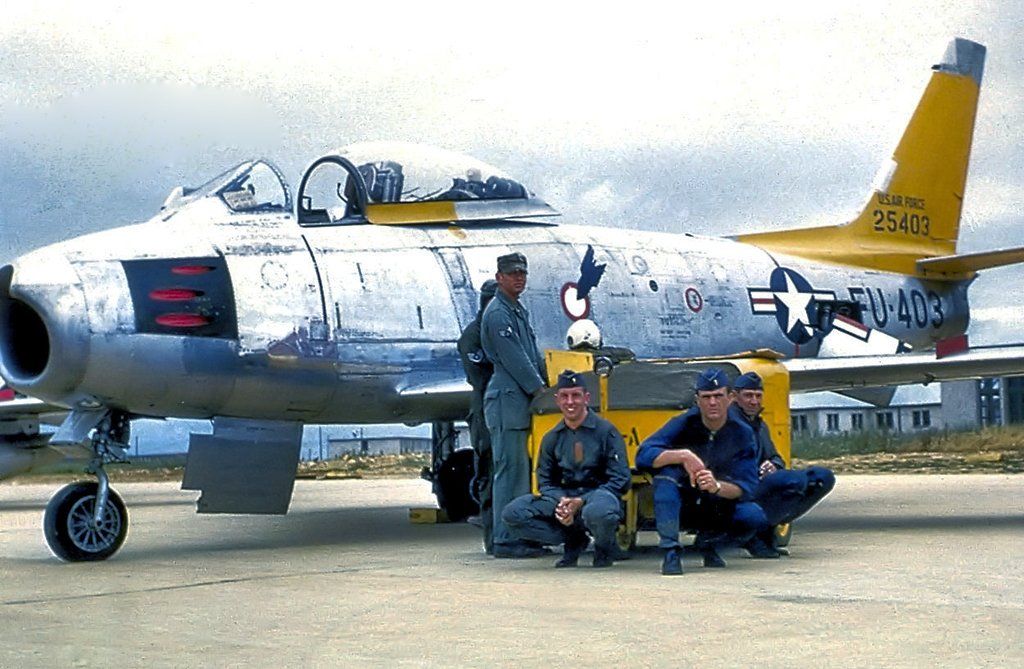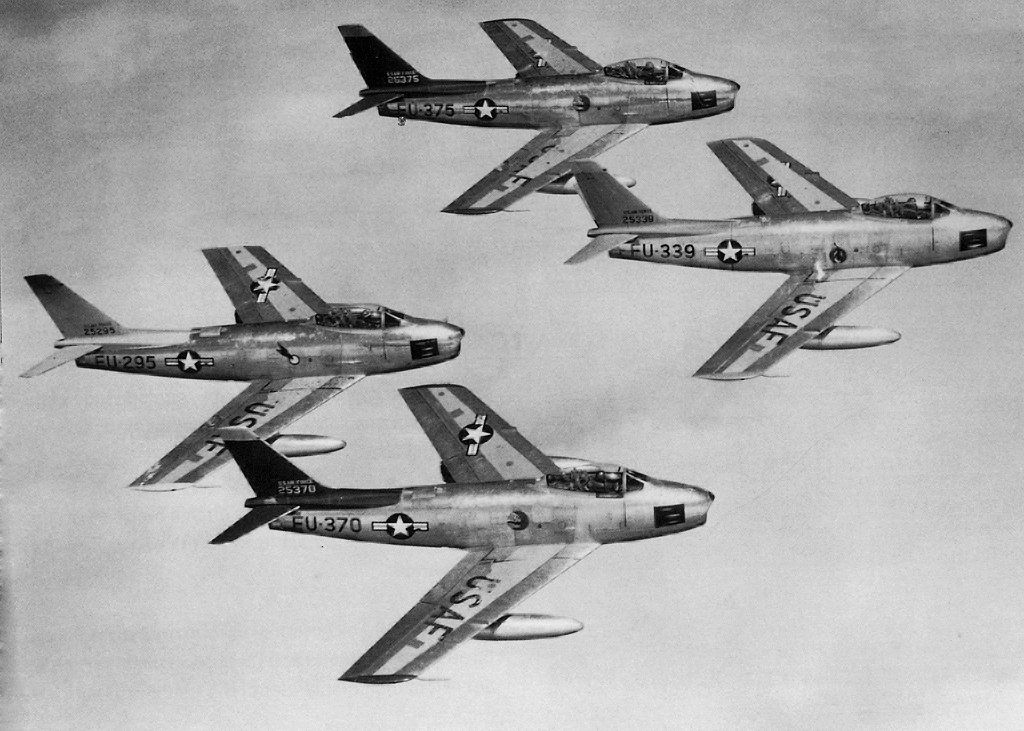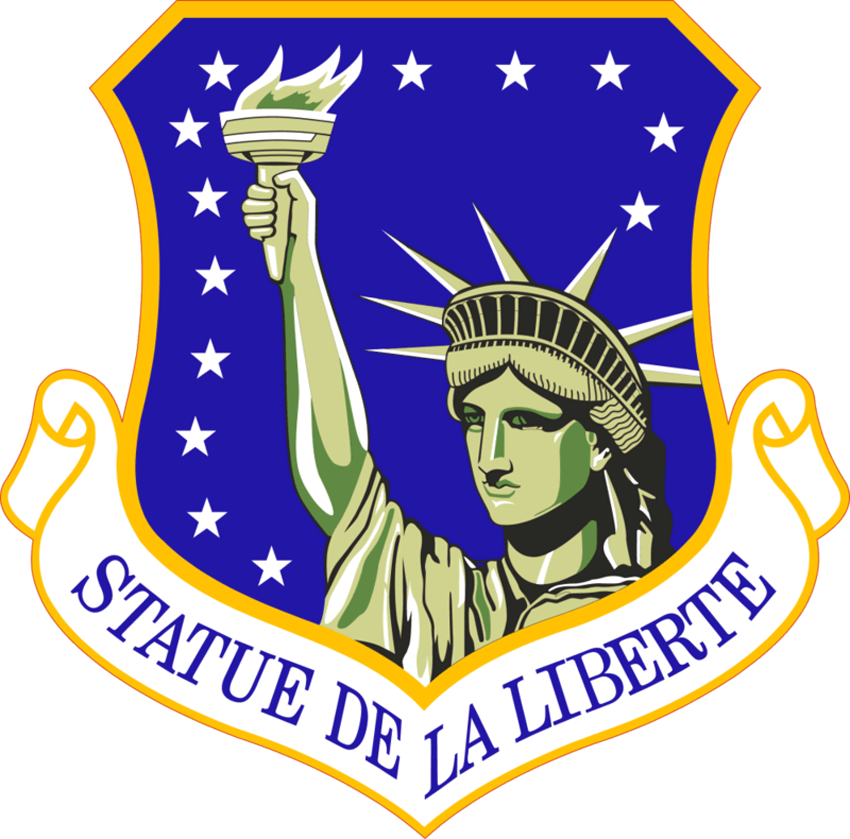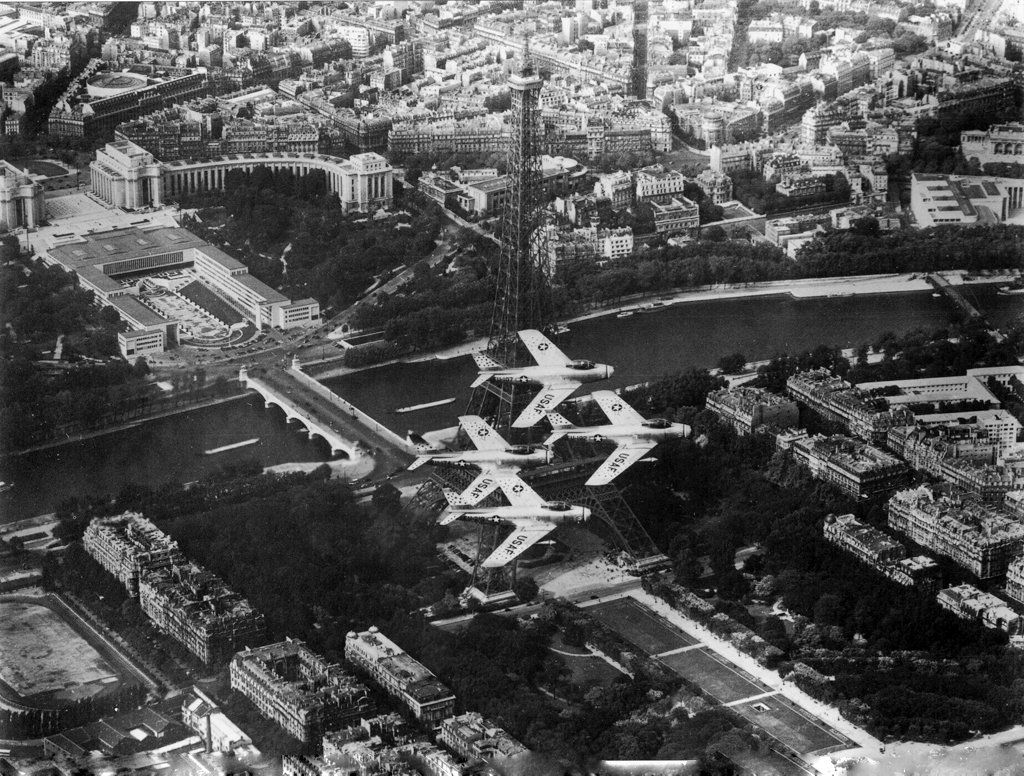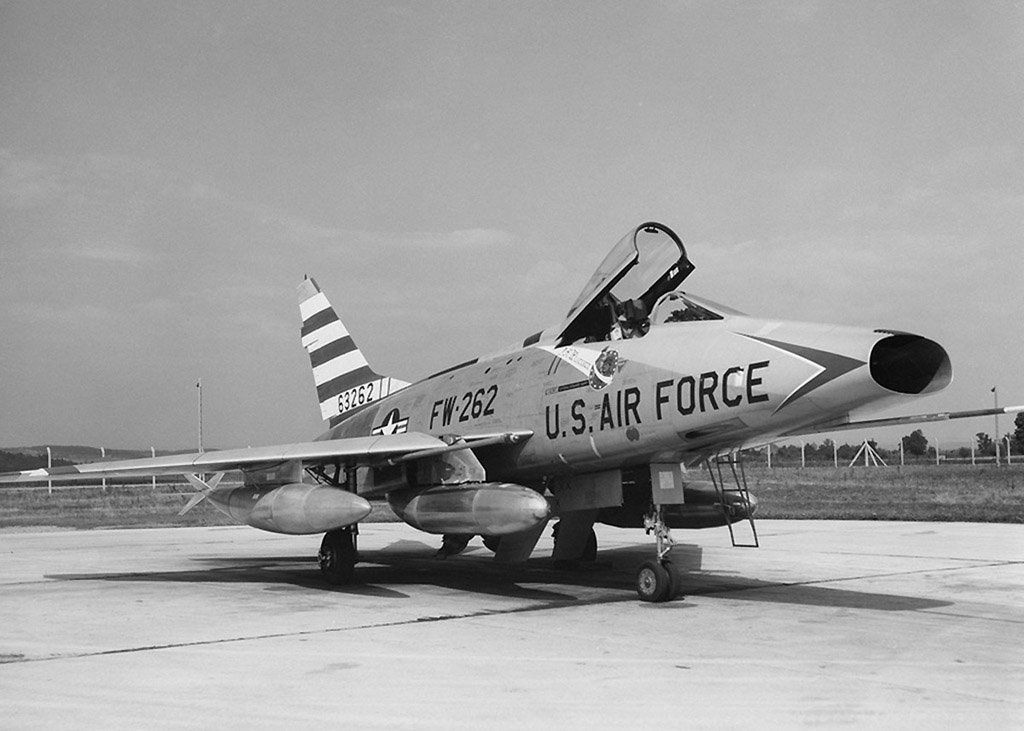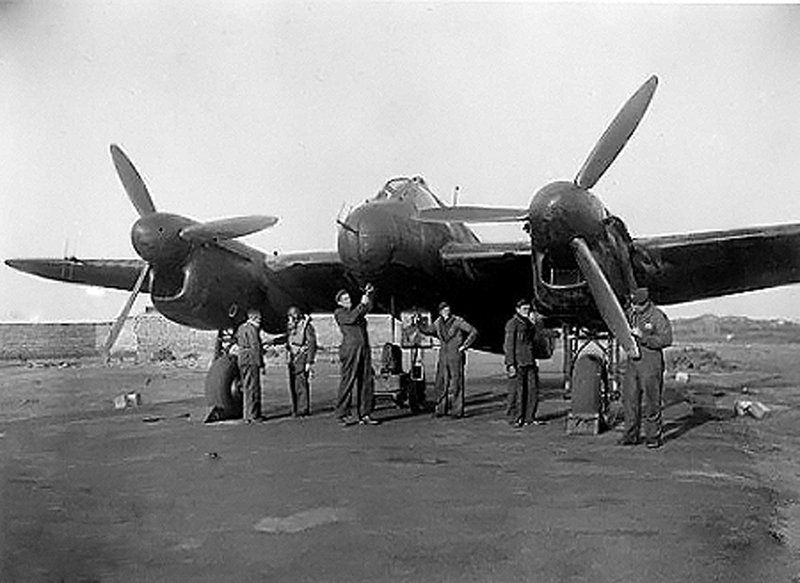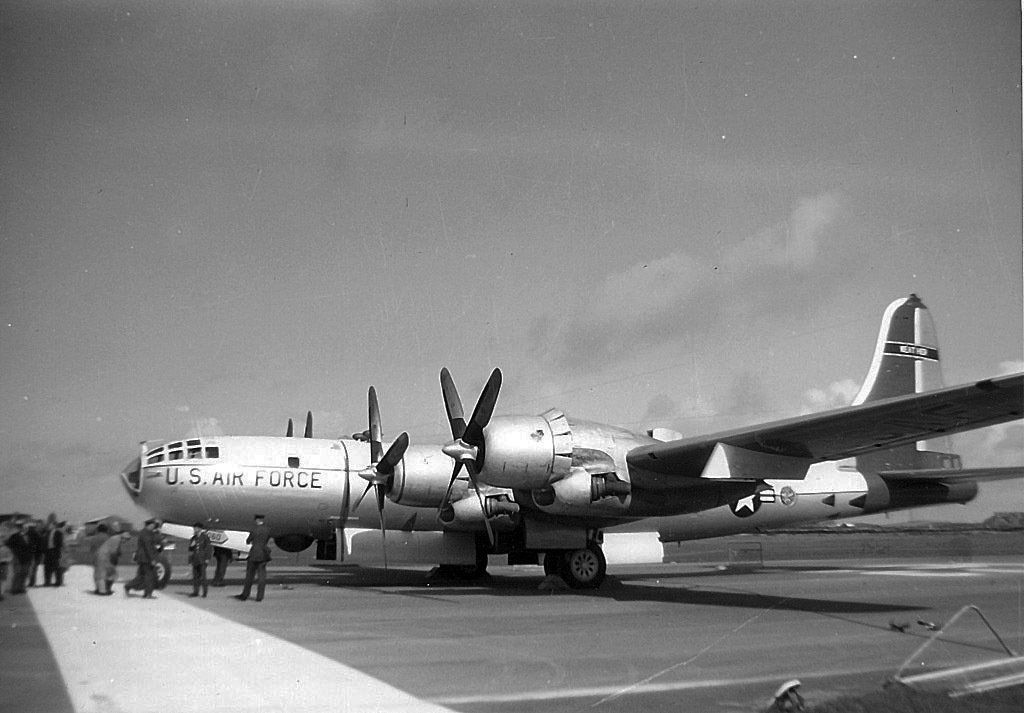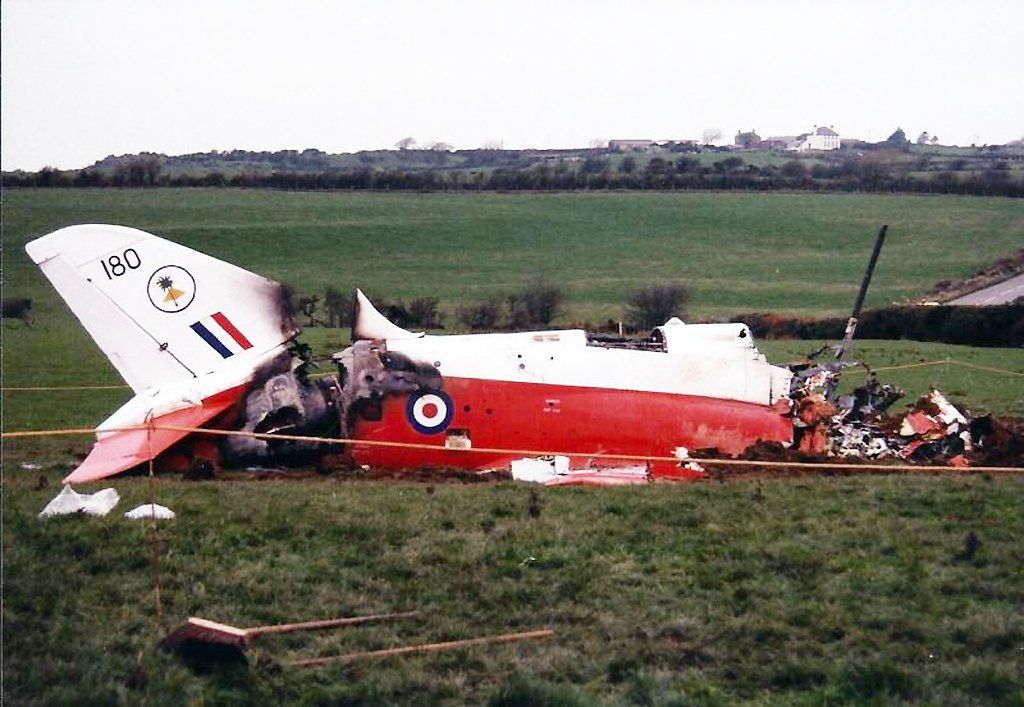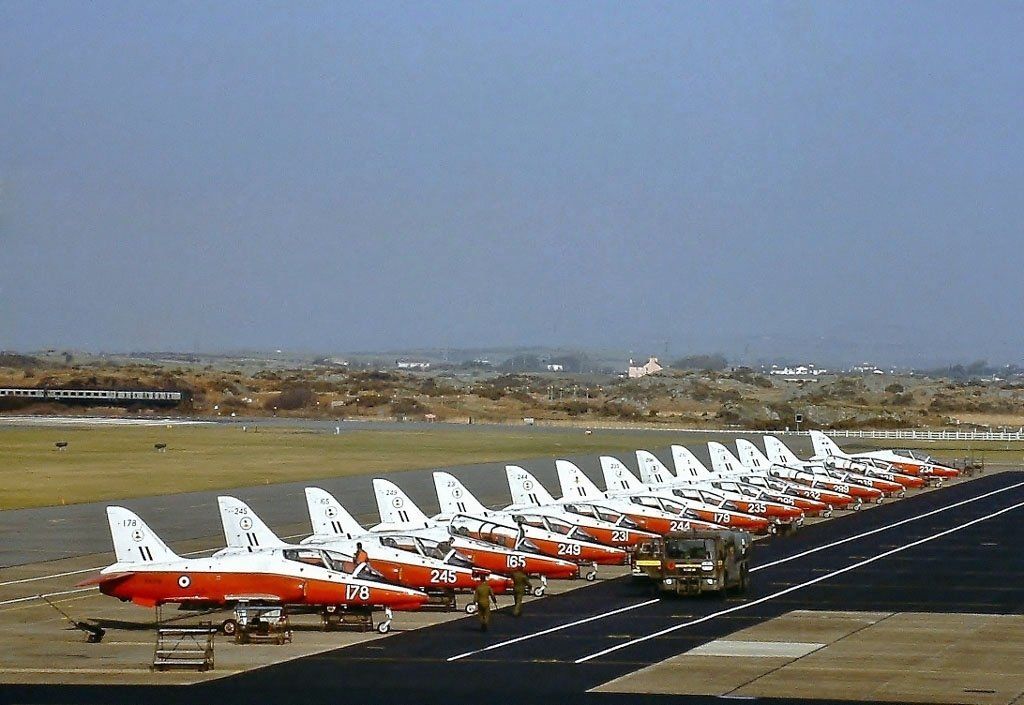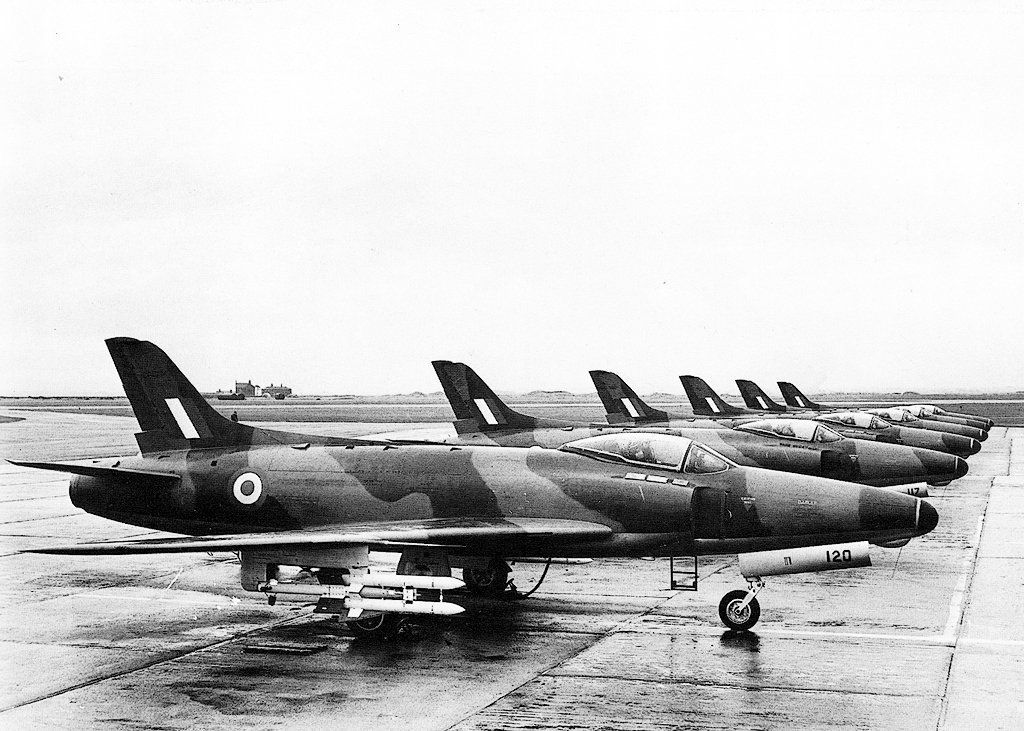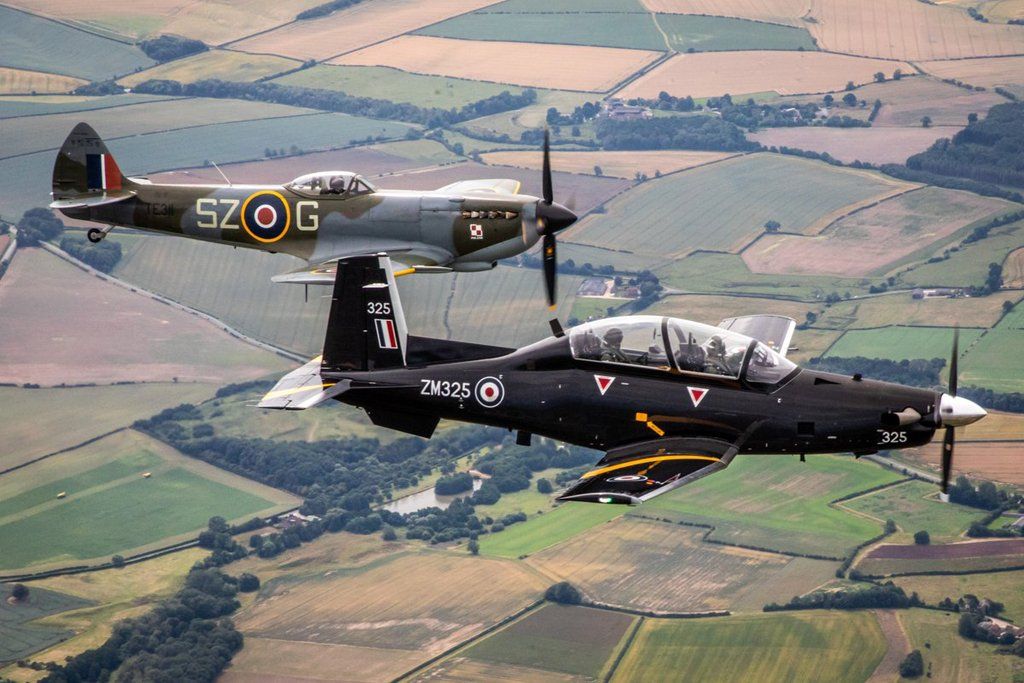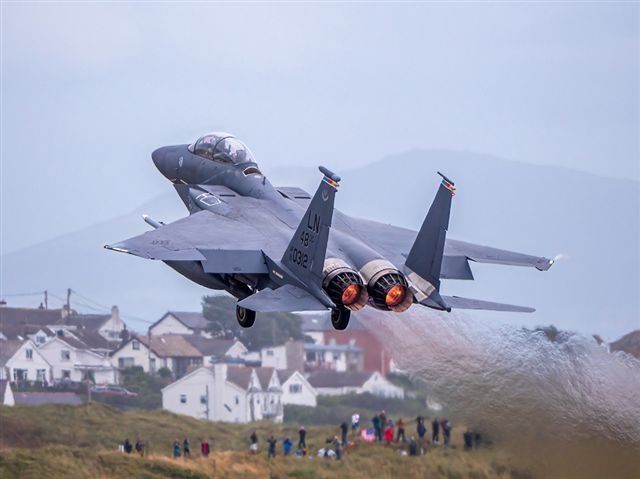48TH FIGHTER WING LINEAGE
AMERICA ENTERS WORLD WAR II

EUROPEAN DEPLOYMENT
They then travelled by train to RAF Ibsley, Hampshire where they were to receive brand new P-47D Thunderbolts (better known as the Jug by pilots) and assignment to the Ninth Air Force. Following a rigorous training programme, its unit designation was modified to simply the 48th Fighter Group with the very first combat mission being flown on 20 April 1944.
This was to involve flying across the English Channel on a fighter sweep along the German occupied French coast. This was then followed by a series of ground attack sorties in anticipation of the Big Day. By then the 48th FG squadrons had received their identity codes of 492nd – F4, 493rd – I7 and 494th – 6M. In addition, the engine cowlings were respectively pained red, blue and yellow.
On D Day, 6 June the 48th was to participate in the massive invasion when 14,000 sorties were flown by the allied air forces. All three squadrons were tasked in attacking bridges, gun positions, fuel dumps, railroads and in providing reconnaissance support. As soon as the beachheads had been secured, they were to transfer to Advanced Landing Ground (ALG) A4 at Deux Jumeaux, France on 28 June and assigned to the 70th Fighter Wing, Ninth Air Force.
Primary missions were then conducted in direct support of the invading ground forces as they moved across northern France towards Belgium; during which time they were to assist the troops in their break out of St Lo in July and were to follow them throughout August and September, moving from one ALG to another, as the allies progressed towards their goal of Nazi Germany.
Whilst at ALG A92 at St Trond, Belgium on 15 October the 492nd FS received a Distinguished Unit Citation. Having just delivered one successful attack, the squadron was urgently requested to stop a German counter offensive led by 30 tanks near Aachen. Despite dwindling fuel, low level strafing attacks were conducted against the spearheading tanks. By the time that the squadron withdrew, the Germans had dispersed.
On 6 December, the ground forces were advancing against a heavily defended area north of Julich. A heavy overcast extended over the entire area. The 48th managed to locate their targets at extreme low level and despite intense AA and small arms fire, that was to damage several P-47s, they eventually managed to demolish the German defences, thus allowing the American troops to capture the area. For this action, the entire 48th Fighter Group was awarded a Distinguished Unit Citation.
In the early hours of 16 December 16, German forces under the command of General von Runstedt launched Operation Crief in the Ardennes as a last ditch attempt to split the advancing allied forces, in order to thrust through to Brussels and on to Antwerp in what became known as the Battle of the Bulge.
Clouds and fog was to constantly thwart air operations together with very low temperatures. Under extreme pressure from the defending allied ground forces, despite constant poor visibility, air attacks were to be essential in pushing the Germans back. Again, the 48th was to be in the thick of it and were to receive their third unit citation for relentless assaults against the enemy.
On 22 February 1945, the 493rd FS was bounced by Me 262s. Although the German jets were unable to get into a firing position, the P-47s managed to damage two, before the jets broke away using their speed advantage. 18 April was to see no less than 110 P-47s fly a total of six strafing missions against numerous targets, including airfields at Oschatz and Grosenheim.
Claims for the day were to include 3 aircraft destroyed and five damaged together with numerous locomotives, trucks, warehouses, barges, a supply dump, a flak tower and a steam shovel! No aircraft were lost, although two returned having sustained damage from intense ground fire.
On 18 May, the 48th Fighter Group was to fly its last combat mission, having flown almost 2,000 sorties, dropping nearly 500 tons of bombs and expending more than 160,000 rounds of ammunition. Although the 48th never had a fighter ace, the Group were accredited with 19½ enemy aircraft destroyed. At 0001 hours on the following day, the unconditional surrender of Germany became effective.
In less than twelve months, the group had moved through seven temporary airfields before finishing up at ALG R10, Illesheim, Germany on 29 April 1945. As the war in Europe had come to an end, soon followed in the Pacific by August, the 48th Fighter Group moved to Laon, France where it remained for two months before all personnel were to return to the United States for a well earned rest. Congregating at Seymour Johnson, North Carolina; the 48th Fighter Group was formally deactivated on 7 November 1945.
Photo 1- 48th Fighter Group at ALG A4, Deux Jumeaux, France in June 1944.
Photo 2 - 493rd F.S. Jugs being refuelled, including42-25683, ´Miss Lace`.
Photo 3 - ´Snuffy` gets some gas!
Photo 4 - A pair of 493rd Jugs prepare to take off on another mission.
Photo 5 - Captain Charles S.Snider with P-47D, 42-25902 ´Frosty`.
Photo 6 - Pilots of the 494th Fighter Squadron pose for the camera at Laon, France in July 1945, prior to their return to the United States.
(USAF Photos.)
THE POST WAR FRENCH CONNECTION
Irreconcilable differences between the East and the West were to precipitate the setting up of the NATO alliance, which was signed on 4 April 1949. Following the end of the war in Korea, USAFE had been reduced to an absolute low and was to comprise only 366 aircraft distributed at seven bases in West Germany and one in Austria. By the end of 1950, USAFE had only two tactical wings, but by the end of 1952 this would have increased to eleven with more than 1000 aircraft.
In February 1951, the United States and France had signed an agreement in order to establish bases in the country. Many of the flying units were to come from the Air National Guard including the 137th Fighter Bomber Wing, Oklahoma ANG which comprised the 125th FBS at Will Rogers Airport, Tulsa; the 127th FBS at Wichita Airport, Kansas and the 128th FBS Dobbins AFB, Atlanta. In order to convert to the nuclear capable F-84G Thunderjet; all three squadrons were first brought together at Alexandria, Louisiana where training was to resume, whilst under control of the 137th FBW. By May 5, the entire wing had flown across the Atlantic to Europe, with the 125th and 127th FBS landing at Ramstein AB and the 128 FBS at Neubiberg, West Germany. On 25 June 1952 the wing was to finally arrive at Chaumont-Semoutiers, France.
By then the wing’s manpower configuration had been revised and augmented with regular Air Force personnel following the transfer out of ANG airmen. Thus, with the exception of those guardsmen who had elected to extend their period of activation or had joined the U S Air Force, few guardsmen actually made the move to France. At midnight on 9 June 1952, the 137th FBW was deactivated with its aircraft and personnel being taken over by the 48th Fighter Bomber Group, which was formally re-activated on 10 July 1952 comprising the 492nd (blue), 493rd (yellow) and 494th Fighter Bomber Squadrons (red). It is interesting to note that the allocated squadron colours did not maintain the identity of their World War II antecedents. (The 137th FBW and its squadrons were then transferred on paper back to the respective state controls).
In the summer of 1953, whilst under the command of fighter ace Colonel Chelsey C Peterson, (who had 8 kills to his credit with the RAF, followed by another 7 with the Eighth Air Force); the USAFE Flight Demonstration Team, Skyblazers was to become the responsibility of the 48th FBW using four of its F-84Gs. However, by November 1953, the wing had completed its conversion to the more capable F-86F Sabre, comprising 75 aircraft with 25 per squadron as well as continuing to be responsible for the Skyblazers team.
In 1884, the French people had presented the Statue of Liberty to the United States, where it was erected in New York Harbour. Because of the 48th continued good community relations with the local French citizens, the mayor of the neighbouring town of Chaumont was to donate a similar, but only 9 foot high bronze statue to the base commander, which had actually been cast from the original Bartholdi mould that had been used to create the design for the original version. The unveiling ceremony was to occur on Independence Day,. 4 July 1954.
In appreciation, the USAFE Commander was to bestow the Statue of Liberty Wing title on the 48th FBW, thus giving it the distinction of being the only USAF wing with an official numbered and named identity. Accordingly, the statue was incorporated into the wing badge. Beneath the badge is the inscription Statue de la Liberté. The red border around the shield symbolises the bravery and valour by which American liberty was won and by which it is maintained. The thirteen stars represent the original thirteen states.
Technological progress was to be swift during the 1950s led by the intensification of the Cold War. Thus in the autumn of 1956, the 48th was to relinquish its thoroughbred Sabres for the F-100 Super Sabre. With a maximum speed of 892 mph, the Liberty Wing had joined the supersonic club. Armed with four 20 mm cannon and able to carry over 7,000 lbs of stores, including tactical nuclear weapons on the centreline pylon, the wing was to eventually receive 90 F-100Ds plus 13 two seat F-100Fs. At this point, the Skyblazers responsibility was transferred to the 36th TFW at Bitburg AB, West Germany.
Concurrent with the F-100 conversion, was to be a new wing commander in December 1956. Colonel Stanton T Smith was to be quite an innovative and charismatic leader and was soon to develop the Bonanza Plan. If the pilots and ground crews completed all their flying schedules before the end of the month, all personnel got the rest of the month off. As a result, effectiveness and team spirit was to be greatly enhanced as proven on 1 July 1958, when every aircraft, including their T-33s and C-47 flew in parade over Ramstein AB. However, the then Chief of Staff, General Curtiss E Le May, who witnessed the fly past, was not to be impressed and the programmes was immediately discontinued, much to the chagrin of the Liberty Wing!
On 8 July 1958, the unit designation was amended to the 48th Tactical Fighter Wing (TFW) and its component squadrons became Tactical Fighter Squadrons (TFS). During this period, the Wing developed its colourful paint schemes as the F-100s were to be adorned with candy stripes of blue/white, yellow/white and red/white for the respective 492nd, 493rd and 494th TFSs. Colonel Smith’s aircraft was to carry all the squadron colours as the 48th became known throughout USAFE as ΄those damn candy stripers`. However, the authorities were soon to stamp out this showmanship, as orders came down from HQ for the aircraft to remove ΄such garish paint schemes`.
In the meantime, murmurings within the French government in regard to America’s storage of nuclear weapons on French soil began to escalate. When Charles de Gaulle was elected President in December 1958, NATO was expecting trouble. De Gaulle’s first aim was to restore France’s influence on world affairs and believed that France did not have to shelter under the American nuclear umbrella and should have its own nuclear deterrent. Six months after his election, he was to demand the immediate withdrawal of all nuclear weapons that USAFE had stationed in France.
This would entail a total of 180 F-100 Super Sabres, which of course included the 48th TFW. On 15 January 1960, the Statue of Liberty Wing was to move lock, stock and barrel to RAF Lakenheath, Suffolk. It was reported at the time, that the pilots had walked out to their aircraft at Chaumont wearing distinctive blue, yellow and red berets. Upon arriving in the UK, they were to don bowler hats of the respective squadron colours!
Aerophile
Photo 1- Home of the 48th FBW at Chaumont AB, France in 1952.
Photo 2 - Skyblazers F-84G Thunderjets in 1953. Note the original 48th badge.
Photo 3 - 493rd FBS F-86F Sabre in 1954.
Photo 4 - 48th FBW Sabres, with 494th FBS in the lead (red fin), flanked by two 492nd jets (blue fin) with the 493rd FBS bringing up the rear with yellow fin.
Photo 5 - Liberty Wing Badge.
Photo 6 - Skyblazers Sabres fly over the Eiffel Tower on 4 July, 1956.
Photo 7 - 494th TFS/48th TFW F-100D Super Sabre in 1958.
